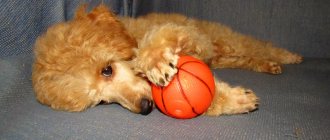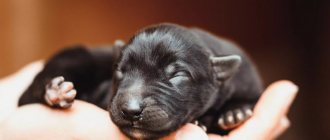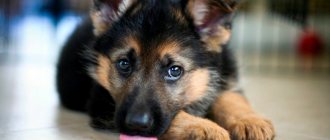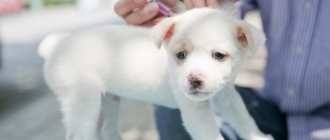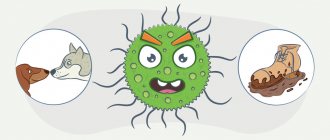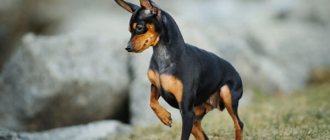The American Pit Bull Terrier, or simply pit bull, is one of the most popular fighting dog breeds today.
These are small, strong dogs, their lifespan is 12-15 years, the most popular colors are black, gray and various shades of brown.
Already from puppyhood, such dogs show all the qualities of a fighter - strength, perseverance, power and stubbornness.
But, like all puppies, pit bull babies are playful, active and friendly.
With proper upbringing, they are sure to grow into loyal friends, guards and companions.
Photos of newborn puppies
Newborn pit bull puppies are small, dense bundles that are unable to see, hear, defecate, or keep themselves warm. The mother does all this for them.
However, their olfactory, sucking and tactile functions are well developed, which allows them to reach the mother’s nipple and receive milk.
A newborn puppy weighs about 250-500 g, and its height is 15-20 cm.
Socialization
The dog requires serious work. You can’t leave a pit bull’s upbringing to chance – the pet will become uncontrollable and aggressive. The owner must be strict, patient and fully aware of the responsibility he assumes.
Socialization of the American pit bull begins as early as possible. The most important period is up to 4 months. At this time, the puppy is introduced to new people, relatives, sounds and smells. If everything is done correctly, the dog will grow up calm and balanced.
Training pit bulls begins with passing the OKD. The animal must remember the most important commands and develop obedience.
American pit bull terriers successfully master the PKS course (protective guard service). Here they learn to manage their temperament, and owners learn to control animals.
Pit bull training is based on rewards. You cannot use violence - he will become embittered and lose the joy of communicating with his owner. Thanks to well-structured lessons, the animal begins to understand the owner perfectly.
The American Pitbull Terrier becomes attached to all family members. The pet is especially affectionate with children and will not offend even a baby. But it’s still worth telling your child about the behavioral characteristics of animals and their body language.
A pit bull will get along with other pets if it grew up with them. Otherwise, he will be jealous of the owner and fight for his attention.
Development from 1 to 12 months
| Age | Size (height) | Weight | Description |
| 1 month | 20-25 cm | 2.5-4 kg | Immediately after birth, the puppy is almost completely dependent on its mother. Of all the reflexes, he only has: sucking, motor, olfactory and tactile. A newborn baby's ears and ears are closed, and there is no thermoregulation. By the end of the first month, the baby's eyes and ears open and he begins to actively explore the world, eat solid food and play with his fellow tribesmen. |
| 2 months | 25-30 cm | 6-9 kg | The 2nd month is called the period of first socialization. At this age, puppies are separated from their mother and find new owners. |
| 3 months | 30-36 cm | 9-14 kg | The baby is actively growing, gaining weight and changing significantly in appearance. At this age, the dog’s future exterior begins to be visible, the musculoskeletal system is actively developing and teeth begin to change. |
| 4-5 months | 35-45 cm | 14-24 kg | The pet grows and develops at a very fast pace, and a relationship between it and the owner begins to be established. At this age, the change of teeth is completed. |
| 6 months | 40-48 cm | 23-28 kg | Early adolescence. The puppy learns the meaning of the hierarchy and tries to find its place in it. At this age, pets can become stubborn and disobedient. Growth and development slow down by the end of the 6th month. |
| 7 months | 45-50 cm | 28-35 kg | The puppy begins to show sexual activity, and also tries to take the highest possible place in the domestic hierarchy. At this time, females are already in heat, and males become more active and can show aggression. |
| 8 months | 48-50 cm | 30-35 kg | At this age, the puppy increasingly takes on the appearance of an adult dog, and also begins to exhibit character traits that will be characteristic of it throughout its life. |
| 9-12 months | 48-50 cm | 30-35 kg | By this age, the pet’s body is almost completely formed. The exterior and character are also formed. If before this time it was not possible to teach the puppy the rules of behavior and commands, now it will be much more difficult to do so. |
What is the price
Due to the fact that the American Pit Bull Terrier is not registered with the FCI, the breed is not considered an elite breed. And yet, in nurseries, the cost of puppies sometimes reaches a fabulous sum. Often it is a reflection of the owner’s ambitions, rather than the real qualities of the animal. Although pit bulls do not participate in competitions, they are still divided into 2 groups:
- Pet class. Pets intended for home keeping. They do not participate in competitions or breeding. Dogs of this class can participate in agility, but do not win prizes. The cost of such puppies is 7-10 thousand rubles.
- Brid and show class. Bright representatives of the breed with a typical exterior. The parents are titled; distant relatives may include American manufacturers. Puppies cost from 30 to 60 thousand rubles.
If the price of a pit bull is too low, it may be a mestizo - a cross with another breed or mongrel due to an unplanned mating. The older the puppy, the less it costs. After six months, some owners give the animal away for free.
At this age, it is more difficult to retrain a dog; you will have to spend a lot of time so that it begins to consider you the owner. Although in other countries it is customary to buy a pit bull terrier at the age of 6-8 months, when the animal already knows all the commands.
It is better to buy a puppy from a nursery. Private breeders, especially those found through advertisements, can deceive the buyer. The kennel must have a good history, it must be clean, and all dogs must be properly cared for.
Basic care rules
Caring for your pit bull's cheeks involves following these rules :
- The training and upbringing of a baby begins from the first day it arrives in the house. This applies to: place, rules of behavior, feeding, walks, etc. Such training involves establishing close contact with the dog, as well as a leadership position from the owner.
- Proper nutrition. Balance is very important here; on the one hand, food must contain all the necessary substances, and on the other hand, the norms and rules of feeding must be observed.
- Caring for a pit bull's coat involves bathing several times a year, as well as regular brushing of teeth, ears, and nail trimming.
- In the first year of life, the dog should be regularly shown to the veterinarian, and vaccinations should be given on time, according to the schedule.
- Taking care of your puppy's health also includes regular administration of anthelmintics (once every 4 months), as well as treatment for fleas, lice and ticks.
- We should not forget that the puppy needs physical activity and needs daily walks and active games. You should walk your baby at least 2-3 times a day for 1-1.5 hours.
- Education and training are an integral part of caring for a pitbull puppy, otherwise the dog can become uncontrollable and dangerous.
Character
Despite all its advantages, this dog causes distrust on the part of many people. If you take Sweden, breeding pit bulls is strictly prohibited there. This was also done in some states of America. In other countries, walking these animals is allowed only with muzzles.
The character of a pit bull dog has been formed over a long period. Today this dog has a friendly and balanced temperament. But the hunting instinct has been preserved, thanks to which the dogs cope well with the role of guarding premises, and are also excellent assistants during the hunt.
Pitbull has the following character traits:
- The desire to constantly be useful to the owner - childishly playful, the pit bull at the same time notices all the needs of its owner. Even if he is unwell, the dog will do everything in his power to become useful and earn gratitude.
- Confidence in his own merits - such a noble feeling of a dog is manifested in the fact that even knowing about his superiority, he will never attempt to show it to the members of the family in which he lives.
- Attentiveness and extraordinary prudence - even pit bull puppies have these character traits. Even as children, they want to appear mature and wise.
- Showing favor towards children - a dog of this breed is characterized by strong devotion to its “pack”, be it dogs or people around it. She behaves very carefully with them and will never bite a child, no matter what he does to her.
Pit bulls are good family dogs and can perform a wide range of different services.
Those individuals with mental disorders were not allowed for breeding. Indeed, pit bull puppies, photos of which you can take a good look at here, can turn into dangerous animals if they are not raised correctly. Therefore, animals that could not control themselves and did not distinguish a person from a dog were destroyed. According to this principle, the gradual formation of the breed took place.
How to toilet train your pet?
As a rule, toilet training a puppy occurs in 3 stages.
The first stage begins from the moment the baby appears in the house. Here it is important to train your pet not to shit anywhere, but to go to one place. Usually the role of a toilet is played by a diaper or a tray with filling.
The next stage is going outside. As soon as you start walking your puppy, you should immediately begin toilet training.
NOTE!
To do this, you should walk with the baby until he wants to have a bowel movement. After the job is done, encouragement must follow.
At the third stage, the pet is taught to defecate only outside. Therefore, you will have to walk him 3-4 times a day after meals, and praise him every time if he did everything right.
Raising a Pit Bull Terrier
As with any other dog, the statement here is true that if you want to get a loyal and stable dog, you need to devote a lot of time and give him a lot of love. There is no need to listen to stories about the need for rough treatment and torture. Being a brave and fearless breed, like any other creature, the pit bull needs love and attention. If you look at the grand champions of the breed, you can see that in the kennels they were treated like members of families. This dog should strive to achieve out of love, not out of fear.
How to feed
The puppy should be fed at least four and sometimes six times a day. Diet: high-calorie, with all vitamins, but in small portions. Ready-made food is suitable, which makes training much easier.
It is necessary to feed the puppy at the same time from the same container (aluminum or plastic), and do not forget to leave fresh water at all times. The diet should contain 120 g of ready-made food granules, previously soaked in water or milk, 100 g of veal liver or heart (chicken as an option), 50 g of sardines and the same amount of low-fat cottage cheese, 1 boiled egg and fresh yolk once a week, 3 liters of milk, 3 liters of water, 100 g of grated apples or carrots.
All this is divided into several meals (at least 4, but 6 are possible). As puppies mature (after 3 months), you can gradually increase the amount of food per meal and reduce the number of servings.
Regular vaccinations and protection against external parasites are required. Once every six months, the dog should be bathed, and it should also be brushed periodically.
How to teach
In this type of dog, the desire for fighting contacts can manifest itself at different ages. Sometimes even puppies strive for it, sometimes already 10 months or more, and sometimes even older than two years. It happens that such a desire is completely absent.
Therefore, puppies require attention, caution and patience. There is no need to wish for a fighting dog as early as possible and to achieve this from him with all your might. This is a very common mistake and a frequent prerequisite for further failures.
How to feed a grown puppy correctly?
A pit bull puppy is fed according to its age; the younger the pet, the more feedings it requires.
Therefore, the number of feedings will be as follows:
- A baby up to 2 months is fed 6 times a day in small portions.
- From 2 to 3 months – the puppy is fed 5 times a day, with portions increasing.
- From 4 to 6 months the dog is fed 4 times a day.
- At 6-8 months, the pet should eat 3 times a day.
- A 9-month-old dog can be switched to 2 meals a day.
IMPORTANT!
A puppy up to 6 months needs more meat than an adult pet, as its body grows quickly and intensively.
History of the origin of the species
The USA is considered the country of origin of the breed. But the history of the pit bull originated in England. The first American pit bull terriers lived in Spain, Ireland, and Holland. English terriers and bulldogs are their ancestors. There is speculation that British laws that prohibited people from keeping large dogs influenced the appearance of the breed.
The restriction did not include terriers suitable for hunting small animals and bulldogs for guarding. Subsequently, crossbreeding resulted in dogs that combine the agility and mobility of the former and the insensitivity to wounds and courage of the latter.
The word "pit bull terrier" stands for "fighting bull terrier" from the English word pit - pit for fights . Dogs of the breed were called pit dogs, bull terriers, and Yankee terriers . The name pit bull terrier has become official; it reflects the purpose and origin of the breed: fighting bulldog - terrier.
American pit bull terriers were first brought to the New World in the mid-18th and 19th centuries. from England and Ireland. They became famous in America thanks to the organizers of dog fights.
Today it is prohibited to import pit bulls into the European Union; owners from Germany must obtain consent to keep the breed. Often used as service dogs.
Weekly menu
Monday:
- Breakfast - kefir.
- Lunch – fresh veal with zucchini or carrots.
- Dinner – oatmeal with baked beets.
Tuesday:
- Breakfast – sour milk or yogurt.
- Lunch – buckwheat porridge with boiled or raw lamb.
- Dinner – baked pumpkin.
Wednesday:
- Breakfast – cottage cheese or kefir.
- Lunch – boiled lung.
- Dinner – stewed cabbage and egg.
Thursday:
- Breakfast – low-fat yogurt.
- Lunch - fresh beef with stewed beets.
- Uzhen – oatmeal with scalded liver.
Friday:
- Breakfast – cottage cheese or kefir.
- Lunch – rice porridge with veal heart.
- Dinner – stewed zucchini with egg.
Saturday:
- Breakfast – kefir or yogurt.
- Lunch – a piece of beef.
- Dinner – stewed cabbage with scalded liver.
Sunday:
- Breakfast – low-fat cottage cheese.
- Lunch – fresh veal with carrots.
- Dinner – baked beets.
NOTE!
The Pit Bull Terrier is a dog breed prone to allergies, so each new product should be introduced with caution.
Factors influencing growth
The harmonious development of pit bulls depends on a group of factors:
- genetic predisposition;
- conditions of keeping the mother dog;
- food, living conditions for puppies;
- absence of congenital pathologies, diseases, infections, helminthic infestations.
One of the most important factors is the dog’s nutrition. The simplest option is feed, premium canned food with a high content of natural ingredients. The most economical and varied is natural food. Meat should predominate in the natural diet of a pit bull up to 6 months of age. The menu itself is varied:
- Beef, veal, lamb, offal.
- Low-fat yogurt without additives, kefir, cottage cheese, yogurt.
- Buckwheat, oatmeal, rice porridge.
- Cabbage, carrots, zucchini, beets.
Vaccination schedule
| Age | Required vaccinations |
| 8-10 weeks | Comprehensive vaccination against distemper, parainfluenza, leptospirosis, hepatitis, parvovirus enteritis and adenovirus infection. |
| 12 weeks | Revaccination against the same diseases. |
| 6 months | Rabies vaccination. |
| 12 months | Vaccinations are completely repeated. |
| Annually | The vaccination will be repeated throughout the dog's life. |
Health
The American Pit Bull Terrier is a strong dog, but the breed is prone to some hereditary diseases:
- allergies (to food, plants, pollen, fleas);
- hip dysplasia;
- hypothyroidism – dysfunction of the thyroid gland. Causes hair loss or obesity;
- heart diseases.
To maintain health, your dog must be vaccinated, treated for worms every three months, and visit a veterinarian regularly.
Hygiene procedures
It is enough to wash a pit bull puppy 2-3 times a year, observing the following rules:
- You should bathe your pet using a special shampoo designed specifically for puppies.
- Water temperature is approximately 37-38 degrees.
- When bathing a puppy, there should be no drafts in the room.
- After washing, the dog should be rinsed thoroughly to remove any remaining shampoo, then wrapped in a soft towel and dried.
- If necessary, dry the puppy with a hairdryer.
- For 2-3 hours, the pet is not taken outside while bathing and is protected from drafts.
Caring for your puppy also includes brushing its teeth. This is done using a special dog brush and dog paste.
The pet's ears are cleaned weekly using a cotton swab and a special lotion. The ears should be examined about once a week for mites and inflammation.
As for the eyes, they should be clean and clear; minor discharge is removed with a cotton swab dipped in tea leaves.
The pit bull's coat does not require special care; it is enough to wipe its paws during walks and bathe it 2-3 times a year.
The pet's nails are trimmed using a special nail clipper, which can be purchased at a pet store.
American pit bull: description of the breed
When you see a pit bull for the first time, you can immediately understand that this is an unusually strong dog. Representatives of the breed are divided into two types - bulldog type and terriers. Sometimes they are mixed.
The weight of dogs is not strictly limited - it ranges from 12 to 36 kg, but most often individuals of this species are found weighing from 14 to 28 kg. According to the standard, any color is allowed, except for “merle”. The color of pitbull puppies also varies. Coat colors are allowed from pure black and white to brindle, with different markings.
The dog's appearance is stern - the unusual shape of its head with rather wide cheekbones, a powerful jaw and a strong “bull” neck immediately catches the eye. The animal has well-developed muscles and a wide chest. The ears can be docked, but the tail is not docked.
How to choose your future pet?
Under no circumstances should you purchase a puppy on the market or meet with a breeder on neutral territory - this could lead to you purchasing a crossbreed or a sick puppy. This should only be done in a kennel, paying attention to the conditions in which the dogs live, as well as the condition of the pets themselves.
In addition, be sure to ask the breeder to show the babies’ parents and their documents.
IMPORTANT!
When purchasing, be sure to evaluate the health and mental state of the animal.
Signs of a healthy puppy:
- He is cheerful, playful and inquisitive.
- It does not emit an unpleasant odor.
- The eyes and ears of such a baby are clean, and the coat is shiny and glossy.
Upbringing
Training a pit bull requires patience. It is good if a person already has experience in raising dogs. The breed is intelligent and inquisitive, so the pets are happy to learn new commands - you just need to find an approach.
A pit bull should not be kept at bay and should be treated in the same way as family members.
The following rules should be followed:
- Reward and punish the dog immediately after its action. There is no point in doing this after a few hours - the pet will not understand anything.
- Bans are in effect all the time. You must not give in and allow the dog to control you through its pitiful eyes.
- You should only praise your pit bull for actions that will be useful in the future.
- You cannot give commands in an aggressive tone. The puppy should not feel afraid.
- Training should be regular and consistent.
First, the pet is trained in obedience. The dog must understand what is forbidden and what is allowed, and in what tone the owner does it. Only then can you move on to basic commands, and then to complex ones. It is better to start training from 3 months.



